Cerebral stroke-induced neurogenesis: insights and therapeutic implications
Stroke, one of the leading causes of global morbidity and mortality, results from disrupted cerebral blood circulation, leads to cellular damage or death. Ischemic stroke, the predominant subtype, r
[...] Read more.
Stroke, one of the leading causes of global morbidity and mortality, results from disrupted cerebral blood circulation, leads to cellular damage or death. Ischemic stroke, the predominant subtype, relies mainly on recombinant tissue plasminogen activator (rtPA) and endovascular thrombectomy for the treatment. Neurological impairments following ischemic stroke highlight the importance of understanding the interplay between neuroinflammation and neurogenesis in brain repair. Research reveals a complex relationship, where inflammation both promotes and hinders neurogenesis, impacting post-stroke outcomes. The subventricular zone (SVZ) of striatum and sub granular zone (SGZ) in hippocampus play pivotal roles in adult neurogenesis, with distinct characteristics and functions. SVZ neurogenesis involves neuroblast progenitors migrating to the olfactory bulb, while SGZ facilitates granule cell generation for hippocampal function. Understanding the intricate processes of neuroinflammation, neurogenesis, and angiogenesis is crucial for developing effective stroke therapeutics. Promising avenues include drug therapy, selective serotonin reuptake inhibitors, antibody therapy, angiogenesis stimulation, growth factor therapy, hormone therapy, miRNAs, extracellular vesicles, and neuroprotective agents. Stem cell therapy, exploring various cell types, holds potential for neuronal replacement and recovery. In conclusion, deciphering the roles of SVZ and SGZ in neurogenesis, unraveling the complexity of neuroinflammation’s impact on repair, and exploring diverse therapeutic approaches highlight the need for comprehensive investigations to enhance stroke outcomes. The multifaceted landscape of stroke therapeutics presents challenges, but ongoing research offers promising avenues for bridging the gap between preclinical findings and clinical treatments.
Mydhili Radhakrishnan ... Sumana Chakravarty
Stroke, one of the leading causes of global morbidity and mortality, results from disrupted cerebral blood circulation, leads to cellular damage or death. Ischemic stroke, the predominant subtype, relies mainly on recombinant tissue plasminogen activator (rtPA) and endovascular thrombectomy for the treatment. Neurological impairments following ischemic stroke highlight the importance of understanding the interplay between neuroinflammation and neurogenesis in brain repair. Research reveals a complex relationship, where inflammation both promotes and hinders neurogenesis, impacting post-stroke outcomes. The subventricular zone (SVZ) of striatum and sub granular zone (SGZ) in hippocampus play pivotal roles in adult neurogenesis, with distinct characteristics and functions. SVZ neurogenesis involves neuroblast progenitors migrating to the olfactory bulb, while SGZ facilitates granule cell generation for hippocampal function. Understanding the intricate processes of neuroinflammation, neurogenesis, and angiogenesis is crucial for developing effective stroke therapeutics. Promising avenues include drug therapy, selective serotonin reuptake inhibitors, antibody therapy, angiogenesis stimulation, growth factor therapy, hormone therapy, miRNAs, extracellular vesicles, and neuroprotective agents. Stem cell therapy, exploring various cell types, holds potential for neuronal replacement and recovery. In conclusion, deciphering the roles of SVZ and SGZ in neurogenesis, unraveling the complexity of neuroinflammation’s impact on repair, and exploring diverse therapeutic approaches highlight the need for comprehensive investigations to enhance stroke outcomes. The multifaceted landscape of stroke therapeutics presents challenges, but ongoing research offers promising avenues for bridging the gap between preclinical findings and clinical treatments.
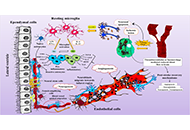 Cerebral stroke-induced neurogenesis: insights and therapeutic implicationsOpen AccessReviewStroke, one of the leading causes of global morbidity and mortality, results from disrupted cerebral blood circulation, leads to cellular damage or death. Ischemic stroke, the predominant subtype, r [...] Read more.Mydhili Radhakrishnan ... Sumana ChakravartyPublished: April 26, 2024 Explor Neuroprot Ther. 2024;4:172–197
Cerebral stroke-induced neurogenesis: insights and therapeutic implicationsOpen AccessReviewStroke, one of the leading causes of global morbidity and mortality, results from disrupted cerebral blood circulation, leads to cellular damage or death. Ischemic stroke, the predominant subtype, r [...] Read more.Mydhili Radhakrishnan ... Sumana ChakravartyPublished: April 26, 2024 Explor Neuroprot Ther. 2024;4:172–197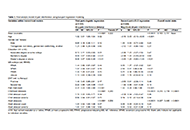 Lifetime stressors relate to invisible symptoms of multiple sclerosisOpen AccessOriginal ArticleAim: Childhood stressors can increase adult stress perception and may accumulate over the lifespan to impact symptoms of multiple sclerosis (MS). Growing evidence links childhood stressors (e.g., [...] Read more.Carri S. Polick ... Sarah A. StoddardPublished: April 22, 2024 Explor Neuroprot Ther. 2024;4:158–171
Lifetime stressors relate to invisible symptoms of multiple sclerosisOpen AccessOriginal ArticleAim: Childhood stressors can increase adult stress perception and may accumulate over the lifespan to impact symptoms of multiple sclerosis (MS). Growing evidence links childhood stressors (e.g., [...] Read more.Carri S. Polick ... Sarah A. StoddardPublished: April 22, 2024 Explor Neuroprot Ther. 2024;4:158–171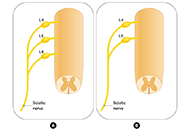 Neuronal plasticity in dorsal root ganglia following sciatic nerve injuryOpen AccessMini ReviewIt is widely known that each tissue has unique mechanisms to respond to injury and maintain homeostasis effectively. Although peripheral nerves have limited regeneration capacity, they conduct a com [...] Read more.Burcu Delibaş ... Süleyman KaplanPublished: April 17, 2024 Explor Neuroprot Ther. 2024;4:148–157
Neuronal plasticity in dorsal root ganglia following sciatic nerve injuryOpen AccessMini ReviewIt is widely known that each tissue has unique mechanisms to respond to injury and maintain homeostasis effectively. Although peripheral nerves have limited regeneration capacity, they conduct a com [...] Read more.Burcu Delibaş ... Süleyman KaplanPublished: April 17, 2024 Explor Neuroprot Ther. 2024;4:148–157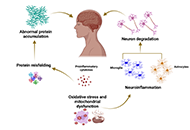 Biomarkers in neurodegenerative diseases: a broad overviewOpen AccessReviewDegeneration and dysfunction of neurons in the brain are hallmarks of neurodegenerative diseases. Over the past decades, significant efforts have been devoted to the development and validation of bi [...] Read more.Sathish Selvam, Velpandi AyyavooPublished: April 16, 2024 Explor Neuroprot Ther. 2024;4:119–147
Biomarkers in neurodegenerative diseases: a broad overviewOpen AccessReviewDegeneration and dysfunction of neurons in the brain are hallmarks of neurodegenerative diseases. Over the past decades, significant efforts have been devoted to the development and validation of bi [...] Read more.Sathish Selvam, Velpandi AyyavooPublished: April 16, 2024 Explor Neuroprot Ther. 2024;4:119–147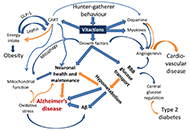 “Vitaction” deficiency: a possible root cause for multiple lifestyle disorders including Alzheimer’s diseaseOpen AccessPerspectiveBehavioural environment and behavioural responses of an individual are known to affect multiple aspects of physiology including neuroendocrine and growth factor signalling, angiogenesis, stem cell d [...] Read more.Milind Watve, Ashwini Keskar SardeshmukhPublished: April 07, 2024 Explor Neuroprot Ther. 2024;4:108–118
“Vitaction” deficiency: a possible root cause for multiple lifestyle disorders including Alzheimer’s diseaseOpen AccessPerspectiveBehavioural environment and behavioural responses of an individual are known to affect multiple aspects of physiology including neuroendocrine and growth factor signalling, angiogenesis, stem cell d [...] Read more.Milind Watve, Ashwini Keskar SardeshmukhPublished: April 07, 2024 Explor Neuroprot Ther. 2024;4:108–118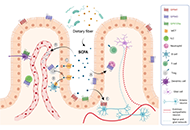 Targeting short-chain fatty acids receptors signalling for neurological disorders treatmentOpen AccessPerspectiveShort-chain fatty acids (SCFAs) play a key role regulating immune and metabolic homeostasis. Consequently, dysregulation in SCFA levels is involved in the pathogenesis of autoimmune, inflammatory, m [...] Read more.Carolina Prado, Rodrigo PachecoPublished: March 19, 2024 Explor Neuroprot Ther. 2024;4:100–107
Targeting short-chain fatty acids receptors signalling for neurological disorders treatmentOpen AccessPerspectiveShort-chain fatty acids (SCFAs) play a key role regulating immune and metabolic homeostasis. Consequently, dysregulation in SCFA levels is involved in the pathogenesis of autoimmune, inflammatory, m [...] Read more.Carolina Prado, Rodrigo PachecoPublished: March 19, 2024 Explor Neuroprot Ther. 2024;4:100–107